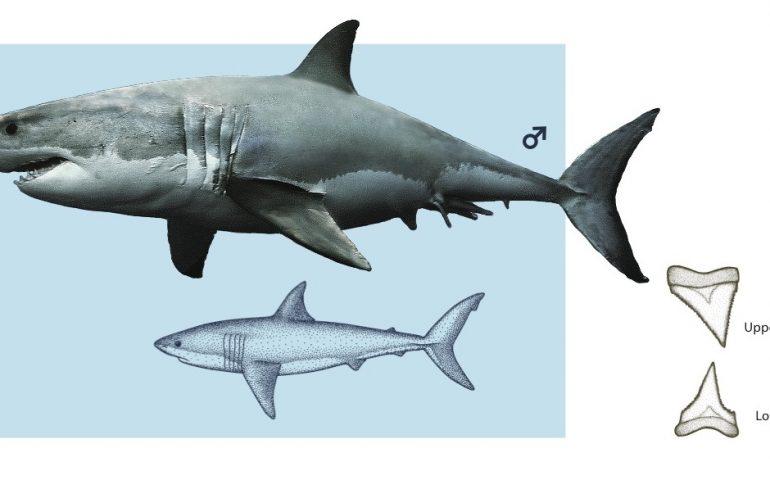Species: Carcharodon carcharias (Linnaeus, 1758); from the Greek carcharodon (rough and tooth), and carcharias (the ancient Greek name for the species).
Alternate Names: It has many names throughout the world. Most common are great white and man-eater. Others include great white death, white pointer, Mango-ururoa (New Zealand), and Grand requin blanc (France). Called Tiburón blanco in Mexico.
Identification: Large, heavy body with the 1st dorsal fin over rear of of pectoral fin; 2nd dorsal fin begins in front of anal fin. Dark metallic-gray, slate-blue, brownish or blackish above, lighter on side, white below. Sometimes has a black spot at the base of the pectoral fin or on the underside of the pectoral fin near the tip. The teeth are very large, triangular, with serrated, saw-tooth edges.
Size: Although reported to 36 feet, and over 4,000 pounds in weight, most are under 21 feet in length. In California reported to nearly 20 feet in length.
Range: From Gulf of California to Gulf of Alaska.
Habitat: Inshore and offshore areas, especially near seal or sea lion rookeries.
Piers: White sharks have been taken at several piers including those at Oceanside, San Clemente, Balboa, Newport Beach, Huntington Beach, Manhattan Beach, Hermosa Beach, Venice, Goleta and Cayucos. Several other piers have reported sightings of great whites—Ventura, Gaviota, and Avila. A great white was reported hooked and lost at the Pacifica Pier in1991. Almost all were young pups under six feet in length although the one that decided to visit Pacifica grabbed a hooked, ten pound or so salmon and was estimated at 12 feet in length and 700 pounds. The carcass of a small, four-foot-long baby white floated by the Point Arena Pier in March of 1997 until grabbed by a couple of the local youth.
Shoreline: Seen near shore fairly often but rarely hooked by anglers.
Boats: Rarely seen although I did see one once while fishing from a boat out of Capitola.
Bait and Tackle: None, illegal to take.
Food Value: None, illegal to take.
Comments: Among the swimmers killed by great whites in California was one who decided to swim with the sea lions alongside the Avila Pier. It was a bad idea. Sea lions are one of the favorite foods of great whites and it’s speculated that many attacks on people wearing wet suits happen because they are mistaken for seal and sea lions.
Great Whites are currently illegal to keep in California. One of the best examples of people trying to help the sharks are anglers at the Oceanside Pier who actually climb down ladders at the pier and try to cut the line as close to the mouth as possible when a great white has been hooked, an increasingly common occurrence at the pier.
“Jaws” was perhaps one of the greatest movies about sharks but it did terrible damage to the image of great whites and put a largely undeserved “scare” in people that exists to today. And of course the “Shark Weeks” shown on TV sensationalize to absurdity great whites on many levels.
The facts are that the great whites seen in our waters rarely attack humans. But, they do attack at times and people have been maimed and killed. The species deserves respect and with that respect comes the advice to stay away from them. They are an apex predator and can be dangerous. In response, untrained people should not confront them in any manner.
